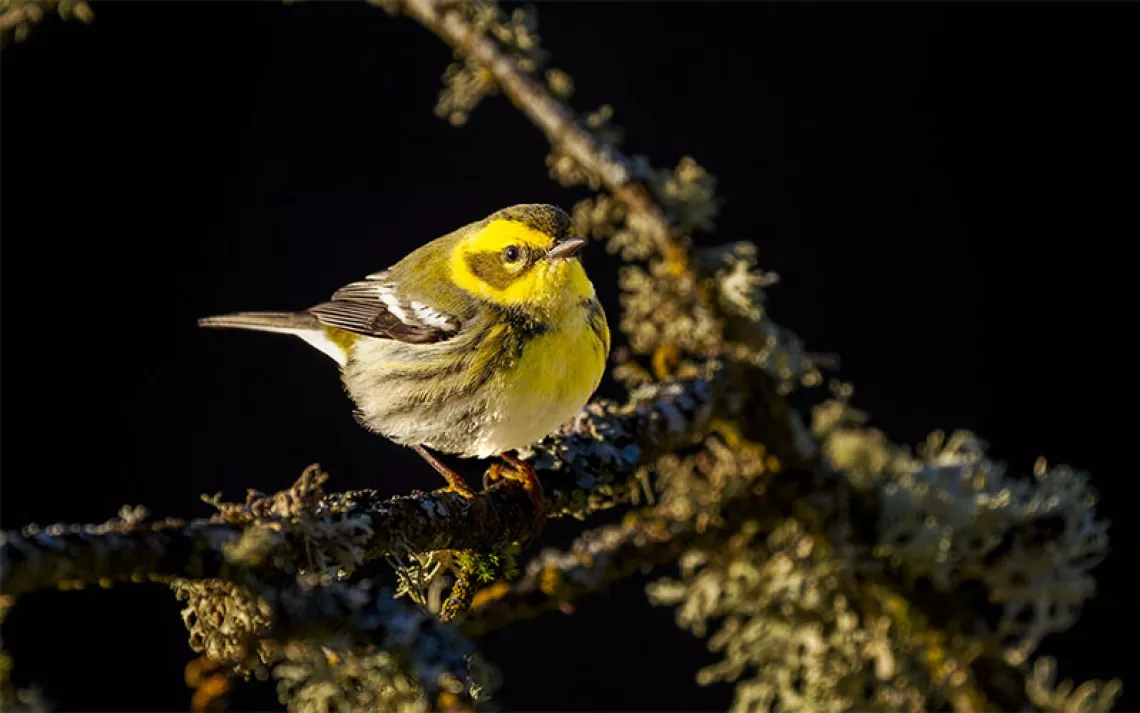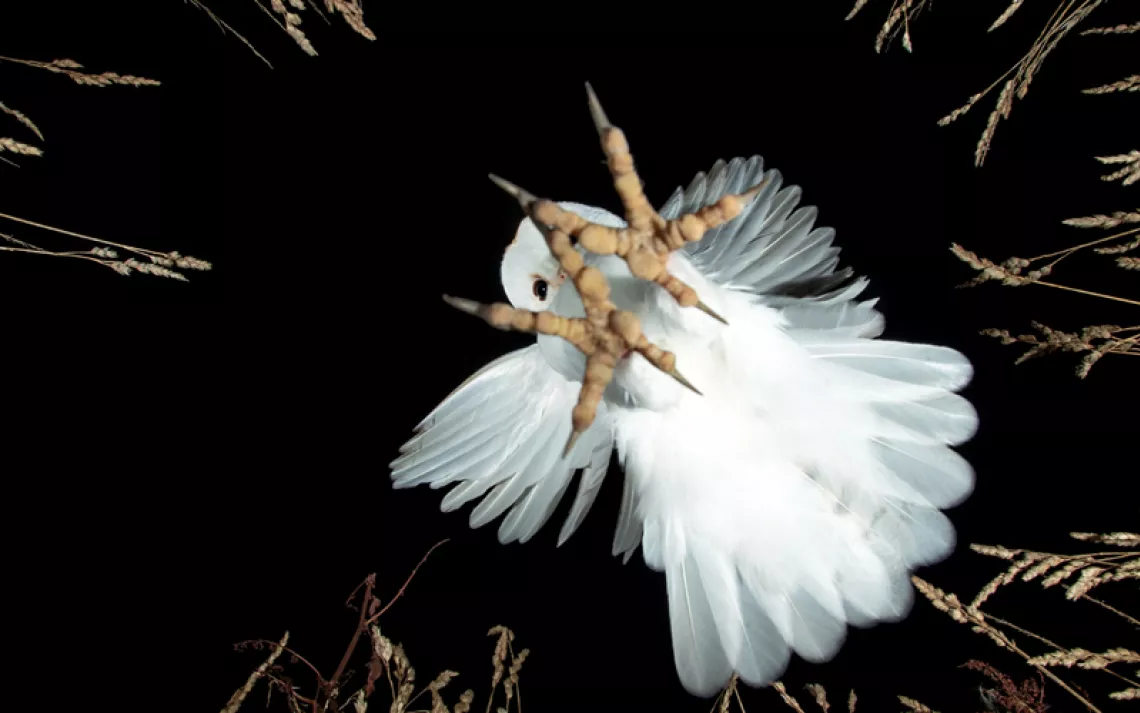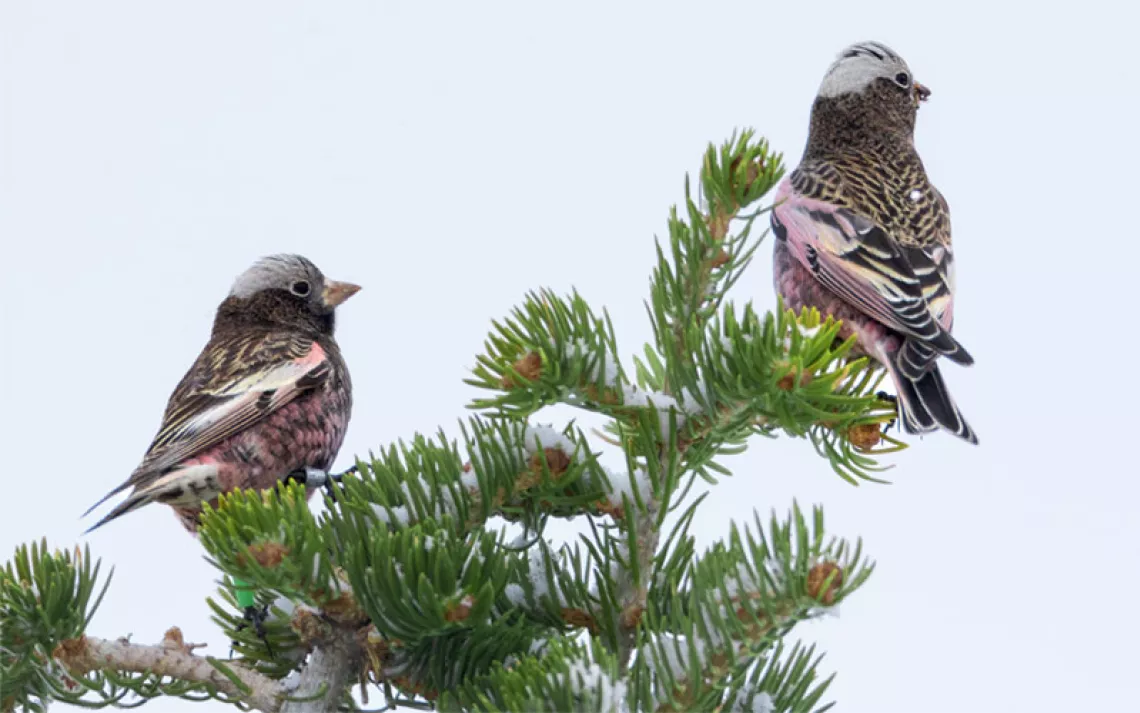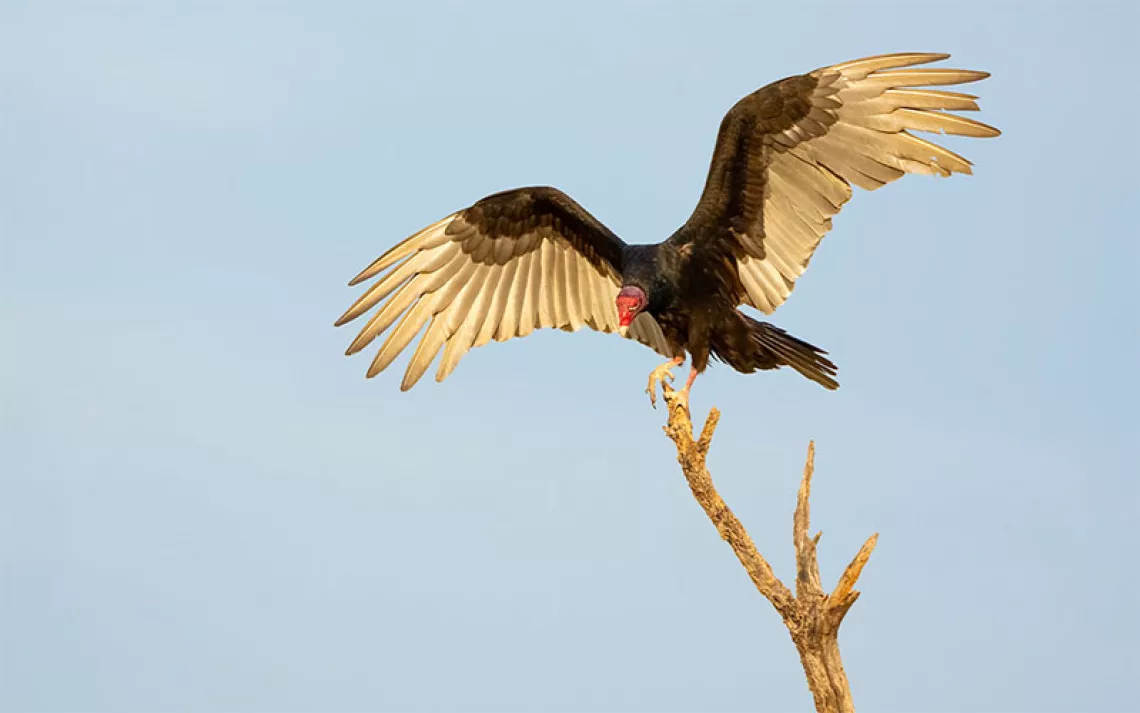Sandhill Crane Spotting Is Alive and Well in Nebraska
Each year, the ancient species traverses North America's distinct flyways
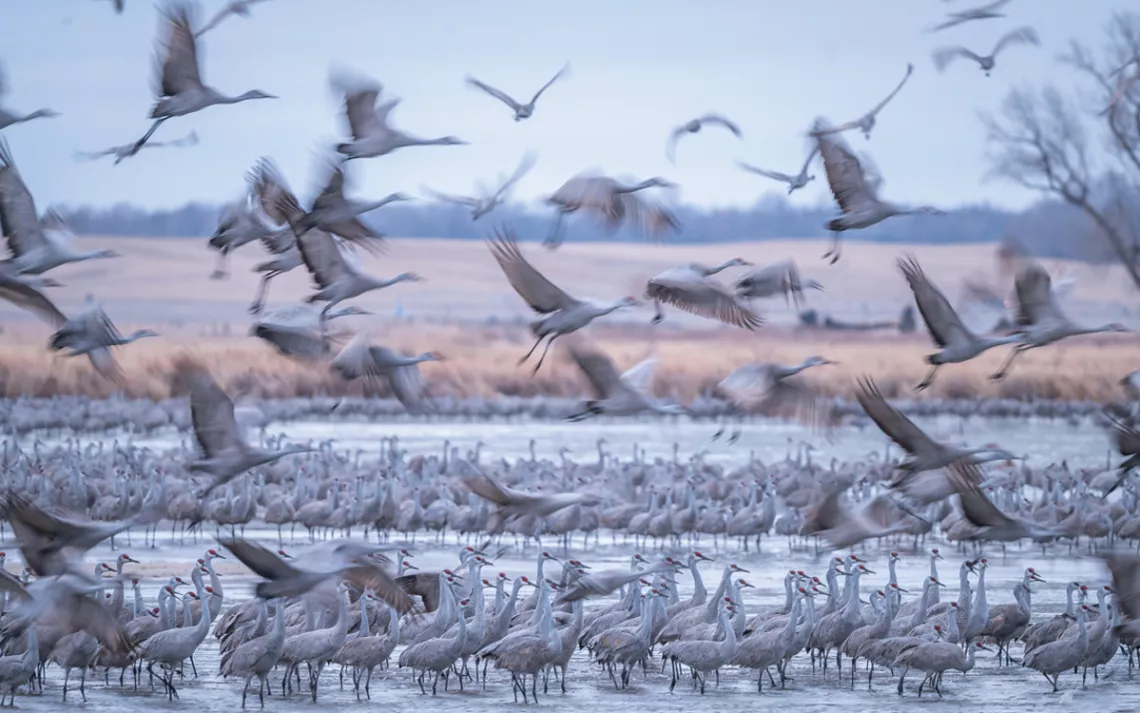
Sandhill cranes at dusk. | Photos by Mariah Lundgren
I heard the sandhill cranes before I saw them—their haunting halloo bugle calls and gooselike honks unmistakable almost three miles away. Then, into my line of sight, hundreds of thousands of the giant birds appeared, each flock forming its own wispy calligraphy across the fiery sky. The cacophony coalesced into a motorized rattle, a sound emanating from the birds' four-foot-long, serpentine tracheas. They floated overhead, hovering above the Platte River's braided, muddy channels, scouting the wetland's long stretches of sandbars for the perfect landing spots before plunging like skydivers, wings cupped and legs dangling. The birds got their name from this place, their springtime Shangri-la: the sandhills of Nebraska.
Between late February and April, more than 500,000 sandhill cranes—that's 80 percent of the birds' total population—pause their northward migration at Nebraska's Platte River valley. Here, among the Great Plains' thawing prairies, the cranes rest, fatten up, and partake in a long-standing ritual, which, according to fossilized crane wing bones, is some 9 million years old: a massive gathering that is part family reunion, part singles dance, part inter-flock house party.

Birdwatchers enter a blind managed by the Crane Trust before sundown so that they can watch the birds on their evening roost.
Each year, the ancient species traverses North America's four distinct flyways, enchanting birders from Mexico to the Yukon and from Mississippi to Montana. The cranes have clearly left an impression. As I traveled through dusty prairie towns across Nebraska, I encountered fantastical crane art on motel walls and gift shop shelves. Restaurant servers gave a knowing nod to the binoculars around my neck—I was another fan in town looking to snag a front-row seat to their state's marquee attraction. During a daytime drive along south-central Nebraska's country roads, I spotted hundreds of sandhill cranes in a single meadow, standing like silver puffer dusters atop stilts. They were bobbing up and down, their long, sleek bills pecking away at the heartland buffet of waste corn, grains, and insects. But I was soon to discover that the real spectacle—the part that drew more than 30,000 visitors from around the world that year—starts at dusk.
One cold, still March evening, I joined several wildlife biologists from the Crane Trust, a habitat conservation organization, in a riverside bird blind. Crane Trust runs a monitoring program and bird count that help biologists better understand the long-term trends of sandhill crane populations. The rest of the year, scientists manage the trust's 10,000 acres, maintaining their hydrological and biological integrity as a life-support system for sandhill cranes as well as other migratory bird species, including the endangered whooping crane. The 1918 Migratory Bird Act was key in saving the sandhill crane from extinction. So, too, was the nearby Rowe Sanctuary in Gibbon—a crane-viewing hot spot that also supports wood ducks, snowy egrets, and many others that rely on the Central Flyway.

Birdwatchers enter a blind managed by the Crane Trust before sundown so that they can watch the birds on their evening roost.
Crane Trust staffers labor to restore the Platte River habitat to its millennia-old, maximally crane-friendly splendor, but Brice Krohn, the president of the organization and a former land manager, noted that much of the land is out of their control. Tallgrass prairies and wetlands are still being converted into agricultural fields, with water diverted for irrigation and development. Even so, he said, the birds have adapted remarkably well. "It's a unique conservation story," Krohn told me, noting that migratory sandhills have successfully transitioned from eating native seeds and grains and small fish to subsisting on whatever they can find in cornfields. One thing Krohn said people like himself can manage? The width of the water. To give the birds room to roost, he said, "We go in and break down non-native vegetation and trees using prescribed fire and discing along the riverbanks to help maintain the prairie."
I stood beside Krohn in the blind, watching thousands of sandhill cranes stand about the banks and swish their feathery bustles as if gossiping. Others drank from the river, tilting their heads back to let water trickle down their long throats. The juveniles rotated in minuets that often devolved into chaotic run-flap-glide dances. The usually graceful birds tucked and arched as they spun, showing off for potential mates.
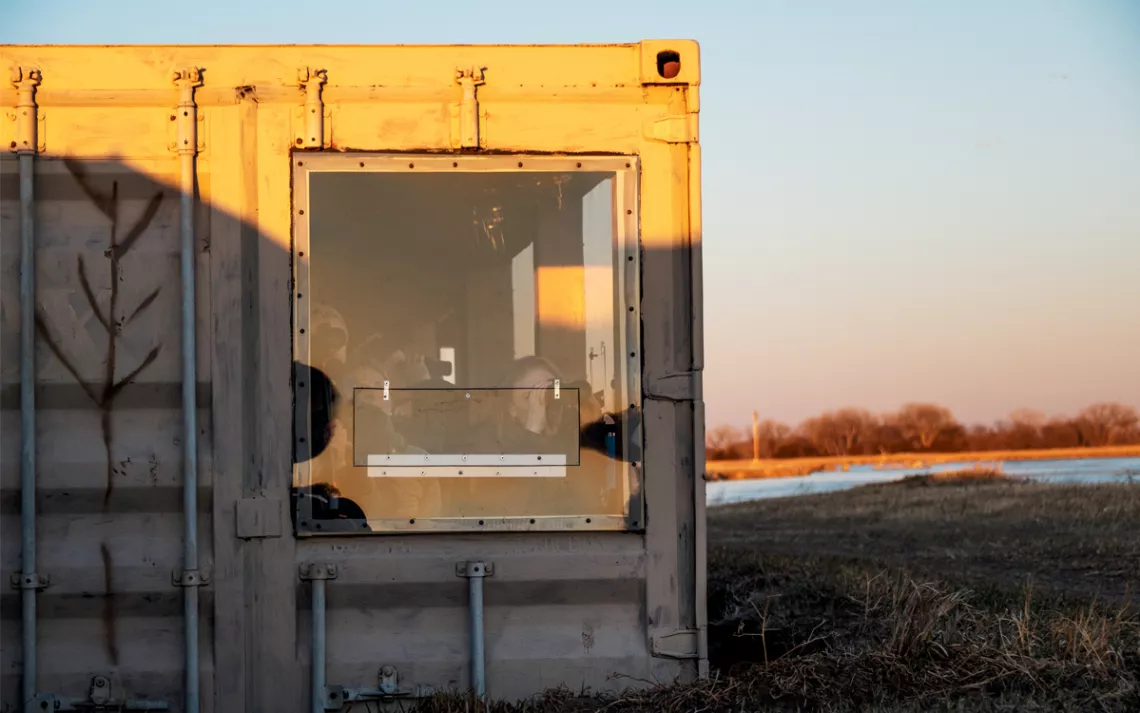
Birdwatchers enter a blind managed by the Crane Trust before sundown so that they can watch the birds on their evening roost.
Lulled by the birds' playful rapport and continual primeval calls, I fell into that rare trance afforded by immersion into something so wild and so primal that your brain can't stop asking "How are there that many of something in my view?" Then I spied the snowy-white anomaly of a bird towering over a line of tour-jetéing, redheaded dancers and gasped. I was double-checking my binoculars when I heard a veteran Crane Trust docent let out a low whistle from the other side of the blind, followed by, "Well, well, if it isn't Bob the Whooper, back from last fall!"
I squinted at the creature, considering how "Bob" was just about the last name that would've come to mind for this bird. Everyone else in the blind started cheering—in a subdued, birdery way, of course—their excitement contagious. "There are only 543 known migratory whoopers in the wild!" Krohn whisper-shouted, referring to whooping cranes.
Years ago, Bob, a juvenile that started his journey in the Aransas National Wildlife Refuge in Texas, made his first confused appearance in Nebraska. "At one time, there were only 21 whooping cranes left in the wild, with two in captivity," Krohn said. He explained that whooping crane parents are known to evict their adult children when they birth new chicks. His guess is that Bob, named after the brother-in-law of a Crane Trust spokesperson who had an unfortunate tendency to get lost, fell in with a flock of sandhills while foraging and apparently came to identify as one. "Normally, whoopers are a little more territorial. . . . From overhead, it almost looks like the sandhills have created a donut or moat around the whooper."
During previous Bob sightings, scientists lamented that it was a shame for such an endangered bird to be running with the wrong crowd, fearing he wouldn't mate successfully. But Krohn was optimistic: More juveniles are now out on their own, thanks to population growth, and they're ultimately bound for the same northern breeding grounds. "There's hope for Bob yet!"
The next day, I was back in the blind before sunrise to observe morning liftoff. The sandhills lingered in the river, dancing to a chorus of meadowlark song, seemingly in no rush to get back to foraging on the farmland. As dawn broke, a lone snow goose flew upstream, causing hundreds of cranes to leap into the air, bugling. Soon after, a soaring, screaming eagle triggered a similar kerfuffle. One of the few birds that showed no adverse reaction? Bob, the marvelous white wannabe, who seemed content to keep obliviously preening the luxurious feathers along his seven-foot wings.
The moral of the story: If scientists and local "craniacs," as some enthusiastic Nebraskans have become known, can restore vital habitat, the core cast members of one of the world's most ancient and mesmerizing natural spectacles will keep showing up to perform. And they might bring along even more exciting guest stars.
Crane Spotting
Nebraska isn't the only place to see sandhill cranes. Check out these other migration hot spots.
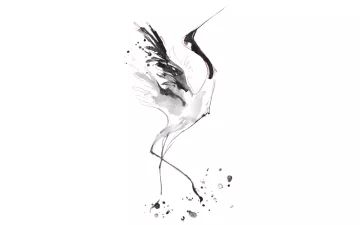
Monte Vista Crane Festival
Monte Vista, Colorado
A spring festival heralds sandhill cranes' return—visitors can partake in tours, photography workshops, and a bird-themed 5K run.
Othello Sandhill Crane Festival
Othello, Washington
A three-day event celebrating sandhill cranes' return to eastern Washington, this late-March festival features wildlife tours (including a field trip to the Columbia National Wildlife Refuge), lectures, an art contest, and children's activities.
Lodi Sandhill Crane Festival
Lodi, California
This early-November festival celebrates cranes' fall migration south.
Sacramento–San Joaquin Delta
Northern California
Wetlands and wildlands along this corridor offer prime opportunities to view migrating sandhill cranes and other Pacific Flyway stars from November to March. The nearby Woodbridge Ecological Reserve offers crane tours in January, February, and March.
Cosumnes River Preserve
Galt, California
Another important Pacific Flyway stopover point for migrating birds in the Central Valley, this area's fertile floodplains make for great fall and spring migration watching.
 The Magazine of The Sierra Club
The Magazine of The Sierra Club
